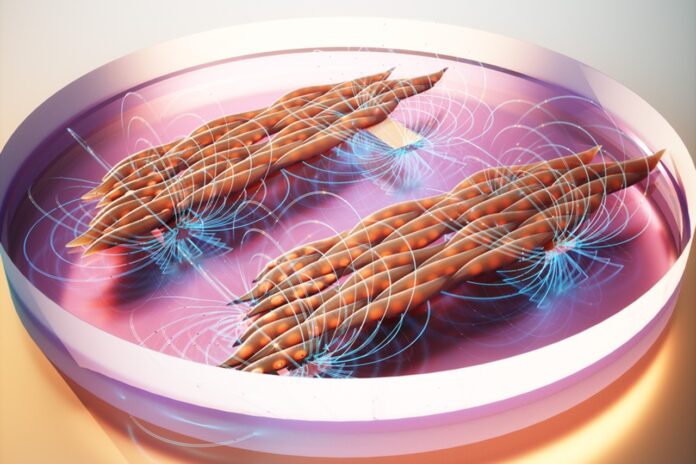Exercise benefits our bodies by making our muscles more robust and more toned. But what’s the exact reason behind this?
While we exercise, our muscles receive signals from nearby cells and experience physical forces from moving against other tissues. Some researchers are curious: Is it the body’s natural chemicals that stimulate muscle growth, the physical motion itself, or perhaps a combination? Finding this answer could be crucial in developing treatments for muscle injuries and neurodegenerative conditions.
MIT engineers have created a unique exercise mat for cells that allows scientists to focus on the purely mechanical effects of exercise at a microscopic level.
This new design is similar to a yoga mat. However, it is made of hydrogel, a soft material similar to Jell-O. It’s about the size of a quarter and contains tiny magnetic particles.
Researchers use an external magnet beneath the mat to move these particles, causing the gel to wobble like a vibrating mat. They can adjust the wobbling frequency to simulate the forces muscles encounter during exercise.
They grew a layer of muscle cells on the gel and set the magnet in motion. Then, they observed how the cells responded to this ‘exercise’ created by the magnetic vibrations.
The initial findings show that consistent mechanical exercise can make muscle fibers grow in a coordinated direction. These aligned and ‘exercised’ fibers can contract together. This suggests that scientists can use the gel to guide the growth of muscle fibers. With this new tool, the team aims to create organized sheets of solid and functional muscles, which could be used in soft robots or for repairing damaged tissues.
Ritu Raman, the Brit and Alex d’Arbeloff Career Development Professor in Engineering Design at MIT, said, “We hope to use this new platform to see whether mechanical stimulation could help guide muscle regrowth after injury or lessen the effects of aging. Mechanical forces play a vital role in our bodies and our environment. And now we have a tool to study that.”
At MIT, Dr. Raman’s lab focuses on creating adaptive living materials for medical and robotic applications. They’re building functional neuromuscular systems to restore mobility in people with motor disorders and power flexible robots. To better understand how natural muscles work, her team is studying how muscle tissues respond to different forces, especially exercise, at the cellular level.
The challenge was to separate the two main aspects of exercise—chemical and mechanical—to see how muscles react solely to mechanical forces. They needed a method to expose muscle cells to repetitive mechanical forces without harming them. Their solution was to use magnets, which are safe and don’t cause damage, to generate these mechanical forces.
The researchers made tiny magnetic bars for their prototype by mixing magnetic particles with a rubbery silicone solution. They then formed a slab from this mixture and sliced it into thin bars. Four magnetic bars were placed between two hydrogel layers, a material commonly used for growing muscle cells. The resulting mat, embedded with magnets, was about the size of a quarter.
They then grew a cluster of muscle cells on this mat, which started as round shapes and gradually stretched and merged with neighboring cells to form fibers.
Next, the researchers placed a magnet beneath the gel mat and moved it back and forth. This caused the embedded magnets to wobble the gel, creating forces similar to those experienced during exercise by cells. They mechanically ‘exercised’ the cells for 30 minutes daily over ten days. In a control group, cells were grown on the same mat but were not exercised.
When examining the gel after this period, they noticed distinct differences between the mechanically stimulated and control cells.
The researchers found that muscle cells exposed to regular mechanical motion grew longer and formed aligned fibers when compared to cells that weren’t exercised. In contrast, non-exercised cells remained circular and had a disorganized structure.
The muscle cells used in the study were genetically modified to contract when exposed to blue light, as simulating them electrically could harm the cells. When blue light was shone on these cells, the control cells had a haphazard contraction pattern, while the exercised cells contracted uniformly in the same direction.
The new gel, named ‘MagMA’ (Magnetic Matrix Actuation), offers a noninvasive way to shape muscle fibers and explore their response to exercise. The researchers plan to use this gel for studying other cell types and their response to mechanical stimulation.
The study introduces a novel approach to encourage muscle cells to align and coordinate their growth using a wobbly gel mat. This innovative method has the potential to be applied in muscle tissue engineering and understanding the impact of mechanical forces on cell behavior.
Journal reference:
- Brandon Rios, Angel Bu, et al., Mechanically programming anisotropy in engineered muscle with actuating extracellular matrices. Device. DOI: 10.1016/j.device.2023.100097.
